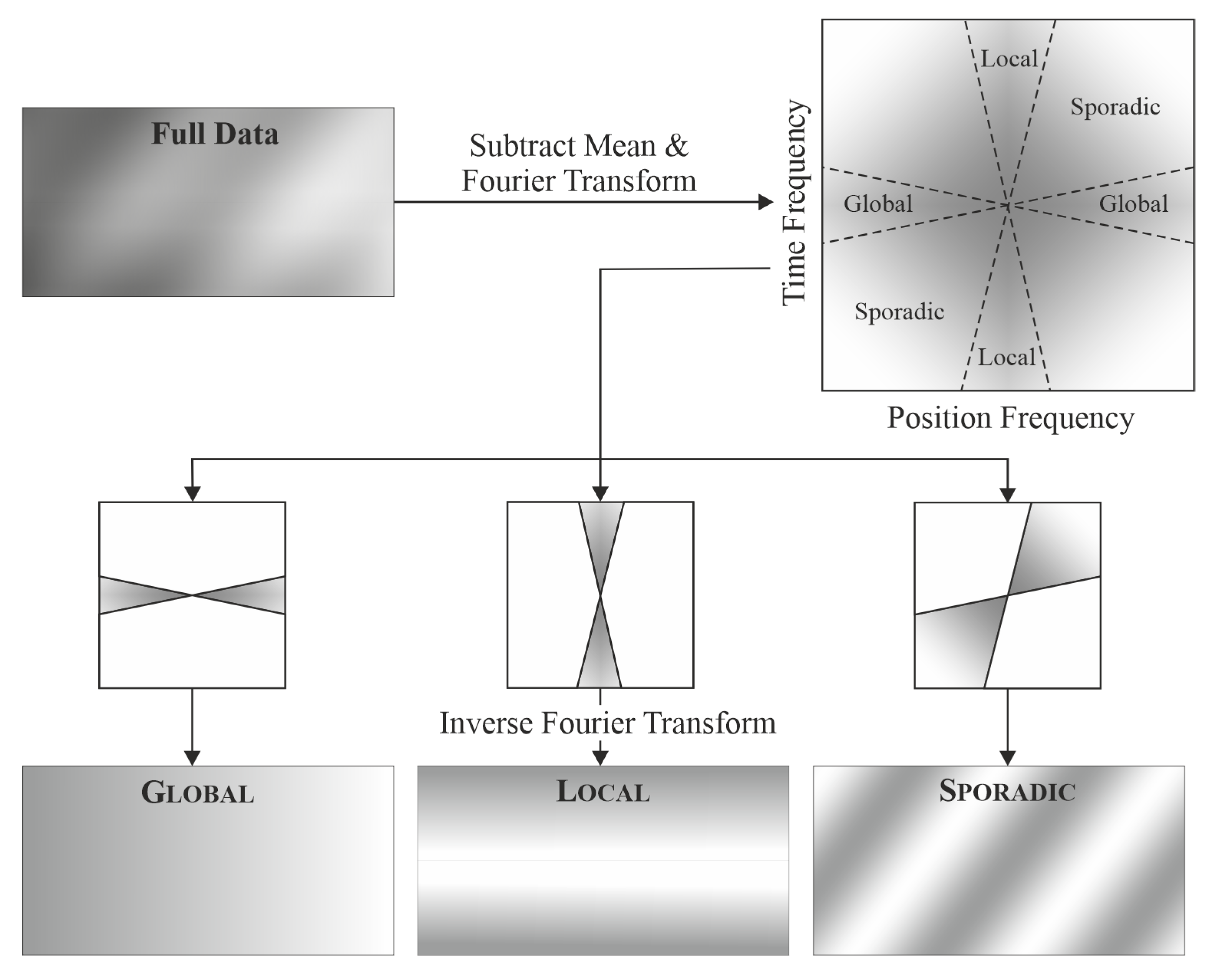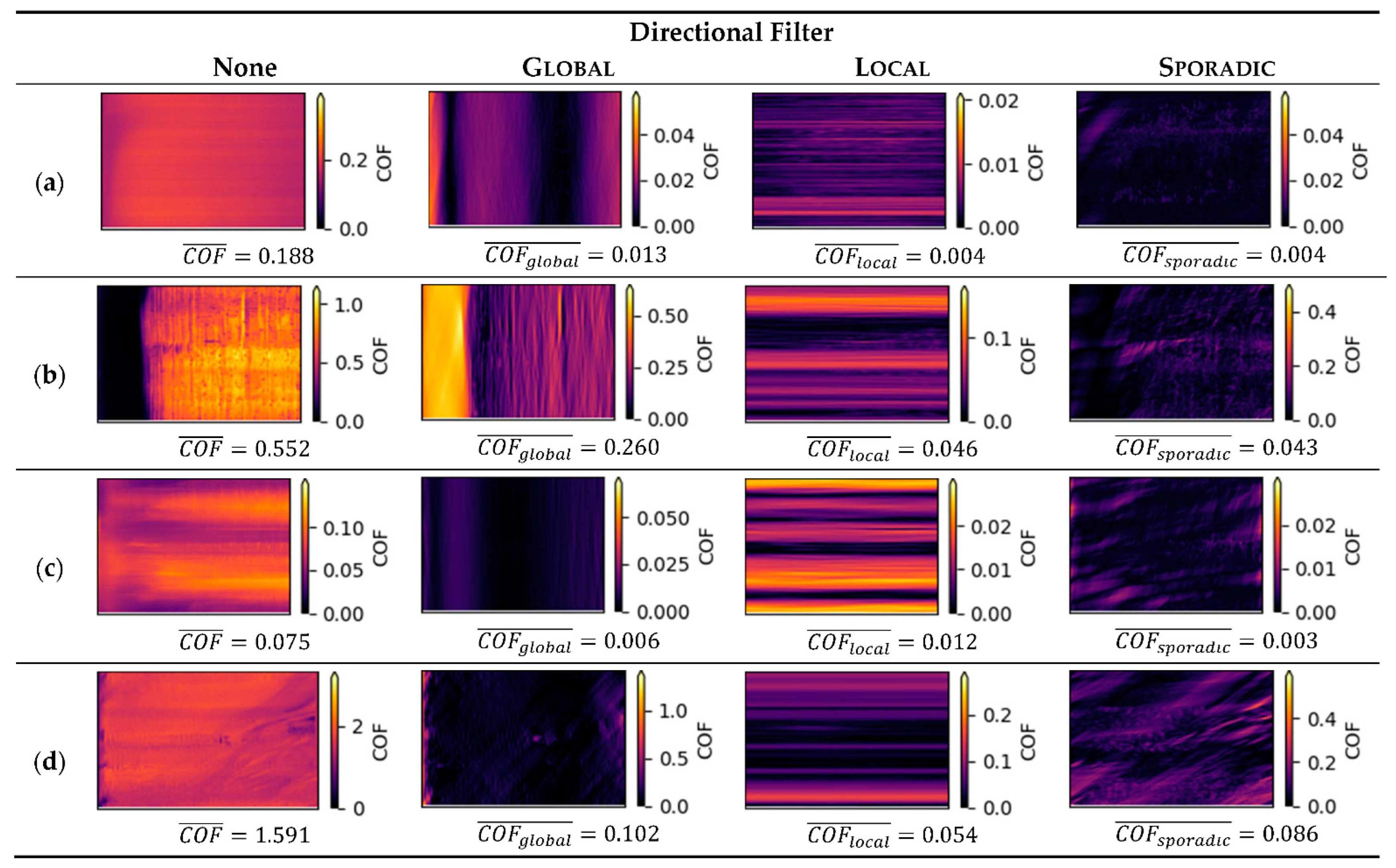Advantages of Using Triboscopic Imaging: Case Studies on Carbon Coatings in Non-Lubricated Friction Conditions
Abstract
:1. Introduction
2. Materials and Methods
2.1. Materials
2.2. Tribological Testing
2.3. Triboscopic Classification
2.4. Quantitative Triboscopy
- Global: to
- Local: to
- Sporadic: to
- Uniform: no limits
- Subtracting mean value
- Discrete Fourier transform
- Filtering amplitudes by direction
- Inverse Discrete Fourier transform
3. Results and Discussion
3.1. Case Studies
3.1.1. Abrasion of Ball Coating
3.1.2. Inhomogeneities
3.1.3. Non-Uniform Track Wear
3.1.4. Detection of Stick-Slip
3.1.5. Debris in Contact Area
3.2. Quantitative Triboscopy
4. Conclusions
Author Contributions
Funding
Institutional Review Board Statement
Informed Consent Statement
Data Availability Statement
Acknowledgments
Conflicts of Interest
References
- Okubo, H.; Sasaki, S.; Lancon, D.; Jarnias, F.; Thiébaut, B. Tribo-Raman-SLIM Observation for Diamond-like Carbon Lubricated with Fully Formulated Oils with Different Wear Levels at DLC/Steel Contacts. Wear 2020, 454–455, 203326. [Google Scholar] [CrossRef]
- Singer, I.L.; Dvorak, S.D.; Wahl, K.J.; Scharf, T.W. Role of Third Bodies in Friction and Wear of Protective Coatings. J. Vac. Sci. Technol. A Vac. Surf. Films. 2003, 21, S232–S240. [Google Scholar] [CrossRef] [Green Version]
- Mangolini, F.; Rossi, A.; Spencer, N.D. In Situ Attenuated Total Reflection (ATR/FT-IR) Tribometry: A Powerful Tool for Investigating Tribochemistry at the Lubricant–Substrate Interface. Tribol. Lett. 2011, 45, 207–218. [Google Scholar] [CrossRef]
- Belin, M. Triboscopy: A New Quantitative Tool for Microtribology. Wear 1993, 168, 7–12. [Google Scholar] [CrossRef]
- Belin, M.; Martin, J.M. Triboscopy, a New Approach to Surface Degradations of Thin Films. Wear 1992, 156, 151–160. [Google Scholar] [CrossRef]
- Wahl, K.J.; Belin, M.; Singer, I.L. A Triboscopic Investigation of the Wear and Friction of MoS2 in a Reciprocating Sliding Contact. Wear 1998, 214, 212–220. [Google Scholar] [CrossRef]
- Sánchez-López, J.C.; Belin, M.; Donnet, C.; Quirós, C.; Elizalde, E. Friction Mechanisms of Amorphous Carbon Nitride Films under Variable Environments: A Triboscopic Study. Surf. Coat. Technol. 2002, 160, 138–144. [Google Scholar] [CrossRef]
- Gnecco, E.; Bennewitz, R.; Gyalog, T.; Meyer, E. Friction experiments on the nanometre scale. J. Phys. Condens. Matter 2001, 13, R619–R642. [Google Scholar] [CrossRef]
- Gnecco, E.; Bennewitz, R.; Gyalog, T.; Loppacher, C.; Bammerlin, M.; Meyer, E.; Güntherodt, H.-J. Velocity Dependence of Atomic Friction. Phys. Rev. Lett. 2000, 84, 1172–1175. [Google Scholar] [CrossRef]
- Steiner, P.; Gnecco, E.; Filleter, T.; Gosvami, N.N.; Maier, S.; Meyer, E.; Bennewitz, R. Atomic Friction Investigations on Ordered Superstructures. Tribol. Lett. 2010, 39, 321–327. [Google Scholar] [CrossRef] [Green Version]
- Steiner, P.; Gnecco, E.; Krok, F.; Budzioch, J.; Walczak, L.; Konior, J.; Szymonski, M.; Meyer, E. Atomic-Scale Friction on Stepped Surfaces of Ionic Crystals. Phys. Rev. Lett. 2011, 106, 186104. [Google Scholar] [CrossRef] [PubMed]
- Socoliuc, A.; Gnecco, E.; Bennewitz, R.; Meyer, E. Ripple Formation Induced in Localized Abrasion. Phys. Rev. B 2003, 68, 115416. [Google Scholar] [CrossRef]
- Bennewitz, R.; Gnecco, E.; Gyalog, T.; Meyer, E. Atomic friction studies on well-defined surfaces. Tribol. Lett. 2001, 10, 51–56. [Google Scholar] [CrossRef]
- Fessler, G.; Zimmermann, I.; Glatzel, T.; Gnecco, E.; Steiner, P.; Roth, R.; Keene, T.D.; Liu, S.-X.; Decurtins, S.; Meyer, E. Orientation Dependent Molecular Friction on Organic Layer Compound Crystals. Appl. Phys. Lett. 2011, 98, 083119. [Google Scholar] [CrossRef]
- Gnecco, E.; Bennewitz, R.; Meyer, E. Abrasive Wear on the Atomic Scale. Phys. Rev. Lett. 2002, 88, 215501. [Google Scholar] [CrossRef] [PubMed]
- Robertson, J. Diamond-like Amorphous Carbon. Mater. Sci. Eng. R Rep. 2002, 37, 129–281. [Google Scholar] [CrossRef] [Green Version]
- Ferrari, A.C. Diamond-like Carbon for Magnetic Storage Disks. Surf. Coat. Technol. 2004, 180–181, 190–206. [Google Scholar] [CrossRef]
- Erdemir, A.; Donnet, C. Tribology of Diamond-like Carbon Films: Recent Progress and Future Prospects. J. Phys. D Appl. Phys. 2006, 39, R311–R327. [Google Scholar] [CrossRef]
- Kennedy, M.; Hoppe, S.; Esser, J. Lower Friction Losses with New Piston Ring Coating. MTZ Worldw. 2014, 75, 24–29. [Google Scholar] [CrossRef]
- Kano, M. Overview of DLC-Coated Engine Components. In Coating Technology for Vehicle Applications; Springer: Cham, Switzerland, 2015; pp. 37–62. [Google Scholar] [CrossRef]
- Andersson, J.; Erck, R.A.; Erdemir, A. Friction of Diamond-like Carbon Films in Different Atmospheres. Wear 2003, 254, 1070–1075. [Google Scholar] [CrossRef]
- Konicek, A.R.; Grierson, D.S.; Sumant, A.V.; Friedmann, T.A.; Sullivan, J.P.; Gilbert, P.U.P.A.; Sawyer, W.G.; Carpick, R.W. Influence of Surface Passivation on the Friction and Wear Behavior of Ultrananocrystalline Diamond and Tetrahedral Amorphous Carbon Thin Films. Phys. Rev. B 2012, 85, 155448. [Google Scholar] [CrossRef] [Green Version]
- Härtwig, F.; Lorenz, L.; Makowski, S.; Krause, M.; Habenicht, C.; Lasagni, A.F. Low-Friction of Ta-C Coatings Paired with Brass and Other Materials under Vacuum and Atmospheric Conditions. Materials 2022, 15, 2534. [Google Scholar] [CrossRef] [PubMed]
- Dos Santos, M.B.; Costa, H.L.; De Mello, J.D.B. Potentiality of Triboscopy to Monitor Friction and Wear. Wear 2015, 332–333, 1134–1144. [Google Scholar] [CrossRef]
- Long, Y.; Bouchet, M.-I.D.B.; Lubrecht, T.; Onodera, T.; Martin, J.M. Superlubricity of Glycerol by Self-Sustained Chemical Polishing. Sci. Rep. 2019, 9, 6286. [Google Scholar] [CrossRef] [PubMed]
- Fontaine, J.; Belin, M.; Le Mogne, T.; Grill, A. How to Restore Superlow Friction of DLC: The Healing Effect of Hydrogen Gas. Tribol. Int. 2004, 37, 869–877. [Google Scholar] [CrossRef]
- Kaulfuss, F.; Weihnacht, V.; Zawischa, M.; Lorenz, L.; Makowski, S.; Hofmann, F.; Leson, A. Effect of Energy and Temperature on Tetrahedral Amorphous Carbon Coatings Deposited by Filtered Laser-Arc. Materials 2021, 14, 2176. [Google Scholar] [CrossRef] [PubMed]
- Krülle, T.; Kaulfuß, F.; Weihnacht, V.; Hofmann, F.; Kirsten, F. Amorphous Carbon Coatings with Different Metal and Nonmetal Dopants: Influence of Cathode Modification on Laser-Arc Evaporation and Film Deposition. Coatings 2022, 12, 188. [Google Scholar] [CrossRef]
- Lorenz, L.; Chudoba, T.; Makowski, S.; Zawischa, M.; Schaller, F.; Weihnacht, V. Indentation Modulus Extrapolation and Thickness Estimation of Ta-C Coatings from Nanoindentation. J. Mater. Sci. 2021, 56, 18740–18748. [Google Scholar] [CrossRef]









| Coating | Thickness /µm | Hardness /GPa | Young’s Modulus /GPa | Composition /at% |
|---|---|---|---|---|
| a-C | 3.2 | 23 | 238 | C: 100 |
| ta-C1 | 3.7 | 40 | 456 | C: 100 |
| ta-C2 | 4.0 | 51 | 519 | C: 100 |
| ta-C3 | 4.3 | 49 | 587 | C: 100 |
| ta-C:B:N | 1.4 | 35 | 400 | C: 85.7 B: 13.1 N: 0.8 Other: 0.6 |
| a-C:Cu | 1.4 | 23 | 271 | C: 84.9 Cu: 14.3 Other: 0.8 |
| Name | Material | Ball Diameter |
|---|---|---|
| Steel | 100Cr6 | 10 mm |
| Copper | Cu | 10 mm |
| Brass | CuZn35 | 10 mm |
| Bronze | CuSn6 | 9.525 mm |
| ta-C1 | see Table 1 | 10 mm |
Publisher’s Note: MDPI stays neutral with regard to jurisdictional claims in published maps and institutional affiliations. |
© 2022 by the authors. Licensee MDPI, Basel, Switzerland. This article is an open access article distributed under the terms and conditions of the Creative Commons Attribution (CC BY) license (https://creativecommons.org/licenses/by/4.0/).
Share and Cite
Lorenz, L.; Makowski, S.; Weihnacht, V.; Krause, M.; Lasagni, A.F. Advantages of Using Triboscopic Imaging: Case Studies on Carbon Coatings in Non-Lubricated Friction Conditions. Materials 2022, 15, 4317. https://doi.org/10.3390/ma15124317
Lorenz L, Makowski S, Weihnacht V, Krause M, Lasagni AF. Advantages of Using Triboscopic Imaging: Case Studies on Carbon Coatings in Non-Lubricated Friction Conditions. Materials. 2022; 15(12):4317. https://doi.org/10.3390/ma15124317
Chicago/Turabian StyleLorenz, Lars, Stefan Makowski, Volker Weihnacht, Matthias Krause, and Andrés Fabián Lasagni. 2022. "Advantages of Using Triboscopic Imaging: Case Studies on Carbon Coatings in Non-Lubricated Friction Conditions" Materials 15, no. 12: 4317. https://doi.org/10.3390/ma15124317
APA StyleLorenz, L., Makowski, S., Weihnacht, V., Krause, M., & Lasagni, A. F. (2022). Advantages of Using Triboscopic Imaging: Case Studies on Carbon Coatings in Non-Lubricated Friction Conditions. Materials, 15(12), 4317. https://doi.org/10.3390/ma15124317









